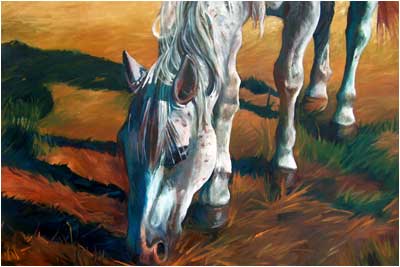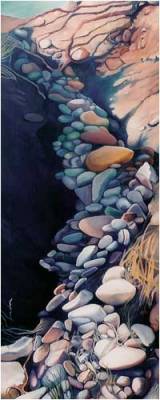Lessons Learned: An Interview With Artist and High-School Art Teacher Susan Sheets, With Advice For Young And Emerging Artists

Susan Sheets has been a high-school art teacher in the Houston suburb of Spring for twenty years, and is one of a rare few K-12 teachers committed to bridging the gap between teacher and professional artist. Many art teachers have strong desires to express themselves artistically, but the high demands on teachers and the challenges of establishing a professional art career are each so high that it's no surprise that most put off public engagement in artmaking - with all of the showing, self-promotion, and professional expenses - until their retirement.
In addition to teaching painting, drawing, and design classes at Spring High School, Sheets has been awarded several painting residencies, ran a gallery and public studio in downtown Spring, and has shown and sold canvases around the state for the past five years. I thought it would be interesting to talk with her about what led her down this challenging path and what, as an "edge case" between the worlds of art and K-12 education, she had learned along the way.
TiP: Tell me your story about how you got drawn to teaching and to art.
Sheets: As a child I really wanted to build things. No one I knew could help me build birdhouses; but I could create paintings and drawings, so my parents sent me to the museum in San Antonio for art classes. When I was in high school, I had a part-time job at an ice-cream parlor where I earned $1.50 an hour. When I earned enough money, I purchased a little tiny oil paint set. Those were the smallest paint tubes I have ever seen, and I was very stingy with the paint. When I went to college, my father expected me to major in nursing at Baylor University. I dutifully took nursing prerequisites until I discovered I really didn't like anything about nursing. That was when I realized I had to examine my own heart and discover what I wanted for myself. Learning to see "inside yourself" is the first lesson I teach my students.
When I moved forward in my education, I went to several universities, and everywhere I went I was advised to get a career not in art, but maybe in a related field. I majored in Interior Design at the University of Houston. I actually practiced as a designer for the home building industry for ten years, and I was happy as a designer for quite a while. Then I looked at my life again and decided that I should be painting. I went back to school to major in painting this time. Somewhere along the way, I had to support myself and applied for a teaching position. I was hired by Spring I.S.D. on an emergency certification. Back to school again, I took education courses and more art courses until I earned a Masters in Art Education.
TiP: How long have you been selling paintings?
Sheets: I remember selling my first painting for $15 to another student in my class at MacArthur High School. She promptly scratched out my name and signed her own and told everyone she painted it! That was 39 years ago! Although I have been selling now and then for many years, my work really began to sell with some popularity about five years ago. My work was in two galleries here in Houston and the equine art was what pleased me the most and sold well to the public.
TiP: Tell us about the classes you teach, and about Spring High School.
Sheets: When I first began, I was given all Art I classes and one year I even taught an English class. Now I teach advanced classes, but I always have Art I classes too. My classes include Art I, Painting II and III, Advanced Placement Drawing Portfolio, Advanced Placement Two Dimensional Design, and Advanced Placement Art History. I have also taught Drawing II and III, and Advanced Placement Sculpture. There are over 3,000 students a Spring High School. My classes this year are larger than they have ever been before. I have 30 students in the largest class and 16 in the smallest. My students are all levels, 9th grade thru 12th grade.
TiP: Are there unique strengths young people possess when it comes to expressing themselves through art?
Sheets: That seems to be the toughest question yet. Because cartooning and anime are so popular and so strong with young people, it is difficult to move them on to new skills. Praise and awe are heaped on young artists for dramatic anime images they have plagiarized or reconstructed. To find their own expression or their own style, young artists have to give up anime and learn to "see and feel" in the real world. It is simply hard work which requires focus. Focus is the most difficult commodity to come by with constant distractions and instant entertainment always available. Young people do have enthusiasm - lots of enthusiasm. They also have angst - lots of angst. Self-expression is only natural. TiP: How have your relationships with students contributed to your development as an artist?
TiP: How have your relationships with students contributed to your development as an artist?
Sheets: Because I wanted to be really good at teaching art, I became a good artist. I took my students to figure drawing classes, I drew every assignment I gave my students, I painted, I drew, I demonstrated. I looked for opportunities to improve and I won scholarship to Arrowmont in Gatlinburg Tennessee. I was awarded a scholarship to Milwaukee Institute of Art and Design for a summer course. I went to Ringling in Florida to see printmaking techniques. I took two courses in Savannah at the School of Visual Arts and I attended a summer course at Chicago Art Institute. Then I applied for and was awarded a residency in Wyoming on a two-thousand-acre cattle ranch. I challenged myself just as I taught my students by challenging them.
I also learned unique and wonderful things from them. Two students in particular are notable. One student was my first AP student 10 years ago who was awarded a "full ride" at Maryland Institute, College of Art. Abe was superb in figure drawing. He never did the obvious "pretty" view, but rather found the most awkward or most difficult angle from which to draw the figure. Until Abe came along and taught me something better, I always did the "pretty" view. The second student was a young man with a language disability. He could never compose essays or write even simple assignments, but he could turn a still life into a roller-coaster ride! His sense of space and movement in a composition was truly awesome. Still-lifes were boring until
learned from my student how to show depth and make a composition really work!
TiP: What do you tell students who want to be artists? What advice do you give them? Do you have many students who go on to art schools?
Sheets: I tell students they can be artists, that there is a future for fine artists, but they need to be the best. With an outstanding portfolio and a good GPA, my students can obtain scholarship (a partial or a full ride) to the art college of their choice. During National Portfolio Review, our school is visited by the finest art colleges in the nation, who come to recruit from Texas. Spring High students are among the best! We have Spring students in art universities across the nation. Every year we have three to five students who apply to art colleges and we have had several students who have received "full rides." Unfortunately, we are plagued by the high cost of college education and too often our students return after one year saying they cannot afford the private art schools. Those who do not go on to art colleges, attend local community colleges. They are generally unsatisfied with the art classes there. I am at a loss as to advise those students. Some seek out the Houston Art Institute, but it also seems very expensive to them.
TiP: What is the biggest thing you bring into the classroom as a "working artist" that would not be a part of your teaching if you just painted casually? I'm thinking about things other than technique, which you are obviously very heavily engaged in and which I'm sure helps your students as well. What else are you able to share with your students, either through your conversations with them or simply through your example?
Sheets: I have learned as a "working artist" a number of things unexpected and infinitely valuable.
- Know how to develop your topic, recognize your "muse" or challenge yourself to create your body of work. Students have to develop their "concentration" for college board portfolios. This is a real struggle for young students, and it was for me as an artist too.
- Always work from direct observation or your own personal photographs. Work to find your subject. Do whatever it takes to document your subject and create your own images. Research your subject until you are an expert. I travel all over Texas, and anywhere in the United States where I might photograph horses in their natural setting. If someone offers to let me photograph their horses, I always accept. I'll photograph anything else that looks interesting at the same time. Some of my favorite topics have been the dogs or cats or birds that are always around the stables.
- Have faith that your work is good, maybe even excellent, and can compete nationally. Search out opportunities and apply for schools, scholarships, grants, and residencies. Don't be afraid to accept when an opportunity is offered or awarded. All Seniors are required to enter the National Art Scholastics competition. It is a good experience for them, and they learn how to enter competitions.
- Be prepared with a portfolio and a body of work to show. This means have slides or images of your work ready to send to competitions or galleries. This requires cataloging and constant photography of new work. Now, I must produce a CD with my work featured so that I can inquire for new representation. I take slides of all of my student's work for their portfolio, but they are responsible for getting copies made for college application etc. Many times I have discovered students have sent off the last slide of their work, and they no longer have the original work to photograph.
- Have other materials prepared and on-hand. Lately I have been asked for photos of myself for advertisement or news articles. A few years ago, I hired a great photo student at Spring to do a series of photos of me, just in case I might need a portrait. I have been so thankful she made a beautiful series for me. Along with your photo, you need a good "Artist's Statement" and a "Bio." I require my students to write an artist's statement when they enter the National Art Scholastics competition.
All works pictured above are posted with express permission from the artist and may not be reproduced without permission. They are, from top: Stomp, Yard Dog, and Cimarron Wash. You can view these and many other works by the Houston-based painter at her website.







No comments:
Post a Comment